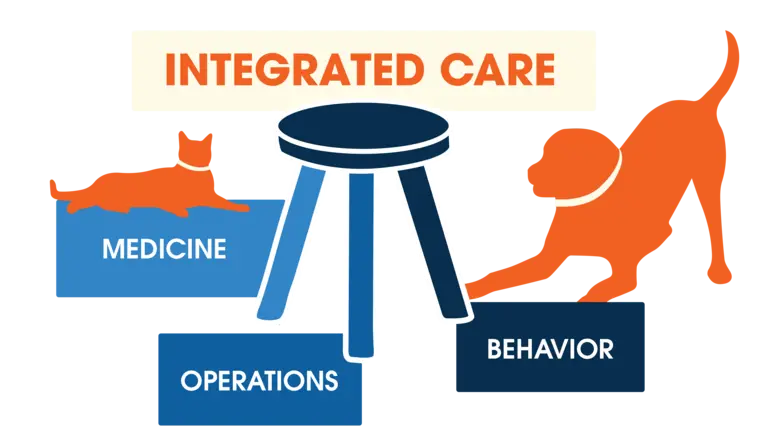Integrated Care in Animal Shelters: What It Is and Easy Ways to Implement

Integrated care in animal shelters is a comprehensive approach to ensuring the well-being of animals through coordinated efforts between shelter staff, veterinarians, behavior specialists, and other support teams. This model aims to address every aspect of an animal's health and well-being (physical, emotional and mental) by working together to provide complete and consistent care. This collaborative approach directly supports the principles of the Five Domains model, which focuses on enhancing the animal's overall experience by addressing their physical health, environment, behavioral interactions, nutrition and mental state. When shelter staff work together across different areas of care, it promotes quicker recovery, reduces stress for the animals and ultimately increases their chances of finding a loving home.
How It Works
-
Medical: Veterinary professionals ensure physical well-being by focusing on medical care including vaccinations, spaying/neutering and treatment for injury or illness.
-
Behavioral: Shelter behavior professionals ensure behavioral health by focusing on behavior support including enrichment, training/behavior modification and social interaction.
-
Operations: Shelter operations staff ensure physical and environmental safety by focusing on necessary daily care, housing and population management.
Together, all teams — medical, behavioral and operations — work collaboratively, sharing knowledge and providing consistent care throughout the animals' stay. Using purposeful communication among teams results in integrated approaches to animal care that can enhance their shelter stay, reduce length of stay and bring them to an outcome more quickly than working independently to meet goals for each animal.
Important points to consider are:
-
Each team has an equal voice in pathway planning and outcome decision-making.
-
Behavior plans don't unnecessarily hinder medical plans, don't hinder operations and all combinations thereof.
-
Group approach to whole animal care, rather than a siloed approach that supports animals.
-
Information sharing and goal-driven communication among teams.
-
The more information shared, the better the care can be.
How To Implement
A key component of integrated care is collaboration among shelter staff, veterinarians, behaviorists and volunteers. By sharing information and resources, each team member can contribute to the overall care plan, ensuring that animals receive tailored support. Integrated care in animal shelters means ensuring that medical and behavioral treatments work in harmony, rather than in isolation. It's about connecting the care—like using low-stress handling during medical procedures or supporting positive human-animal interactions without worsening a medical condition—so that one area of treatment doesn't hinder progress in another. This reduces the likelihood of animals being overlooked or misunderstood, leading to better outcomes and, often, reduced length of stay.
Additionally, integrated care helps shelters manage resources more efficiently. This approach can reduce length of stay, ease overcrowding and reduce the need for costly treatments, making the shelter environment safer and more manageable.
Here are a few ways to start implementing an integrated care approach at your shelter:
-
Population rounds involving veterinary, behavior and operational team members
-
SOP for decision-making process
-
Group decisions for pathway planning and outcomes
-
Protocol for how to track behavioral observations and report on their interactions (positive and concerning)
For both the animals and the people working with them, integrated care creates a more compassionate and effective system, ensuring that every animal receives the best chance for a healthy, happy life.
We have lots more on this subject:
